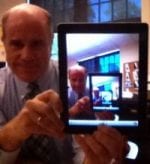One aspect of Hackley School’s Health, Wellness and Well-Being Initiative is Mindfulness Practices in Schools. Very recently, Hackley held a professional development day on its new initiative which included a workshop on Mindfulness by Arthur Zajonc and Grace Bullock. Mr. Zajonc is Director of Mind & Life Institute, which has “pioneered the field of contemplative science.” According to Psychology Today, Mindfulness is “a state of active, open attention on the present… Instead of letting your life pass you by, mindfulness means living in the moment and awakening to experience.” This past fall, at another Hackley professional development day about technology in education, keynote speaker, Clive Thompson (author of Smarter than You Think), mentioned the ideas in Alex Soojung-Kim Pang ’s book The Distraction Addiction as a possible counterpoint to his own fairly rosy view of the positive of the role technology in society. After reading Mr. Pang’s book, I realized that it was less about addiction to the distracting uses of technology and more about the idea of “contemplative computing” (also the name of Mr. Pang’s blog). I did not see it as a counterpoint to Mr. Thompson’s talk but a complement.
In the book, Mr. Pang lays out steps for understanding one’s relationship with technology which he calls “entanglement.” He describes our use of technology as extensions of our minds and suggests ways to become conscious of the ways we depend on technology. Recognizing the topic of multitasking, he recommends that we examine when we multitask (multiple actions toward a single purpose) versus “switch tasking” (multiple actions towards multiple purposes). He encourages technology users to take digital sabbaths and step away from technology not only to understand the place of technology in our lives, but to become more mindful overall. Mr. Pang also briefly addresses contemplating how technology can at times help us become more mindful, giving his own example of using digital photography to take time to appreciate the environment around him. Ironically, I found more mindful ways to read non-fiction, by making use of digital highlighting, note taking and searching tools, but The Distraction Addiction is not available as an ebook. By taking the time to recognize our entanglement we can better control it, he explains.
In another book recommended by Mr.Thompson, Program or be Programmed , the author, Douglas Rushkoff, examines how use of technology has affected our relationship with society and culture. Mr. Rushkoff also set up the book as guide for navigating our way in a culture now deeply affected by new communication tools and social media. He discusses the importance of our own identity and the dangers of anonymity. Most importantly, I think, he points out the necessity for understanding what happens in the conversion of our analog world to the digital. Digital recordings are mathematical representation of an event based on measurement whereas an analog recording is a “physical impression”. He encourages the reader to be conscious of the difference of person to person communication (38% pitch, volume and tone, 55% body movement) versus interaction through digital technology. His conclusion is the best way to understand technology’s place in life and society is by understanding how it works. This includes, from the title of the book, gaining understanding of programming. He believes that it is important for us to learn to code so that our digital world is not biased to those who can. As a long time advocate of computer science in the curriculum, I could not agree more. Even the the simple understanding of how many lines of code (over 50 million to create Facebook) it takes to implement much of the software we use on daily basis, grants us a better appreciation of the technology we use.
Last spring, I wrote about the how faculty at Hackley employ new technology to transform student learning. As we embark on an initiative to use iPad’s in the 9th grade curriculum next year, we will be taking one step further towards giving students a tool that provides them ready access to information and software to help them transform their own learning. Beyond Clive Thompson’s recommendation, one of the things that attracted me to Mr. Pang’s book was the word “distraction.” One of the constant themes that emerged throughout the planning stages was the potential for a personal device to distract students in the class room. However the element of distraction is not new to the classroom with arrival of the iPad. Ultimately, Hackley decided to launch the iPad initiative because of the transformative possibilities. As they have always done, teachers will work with student to help them become more mindful of their classroom environment. Having the experience of using a mobile device in school with instructors will help them understand the role of the device in their lives. Since it also will not always be needed for the classroom, students can learn balance of use. I am looking forward to the possibilities technology will bring to classroom. I also continue to look forward to working with students to understand how to become mindful of technology in their lives.
